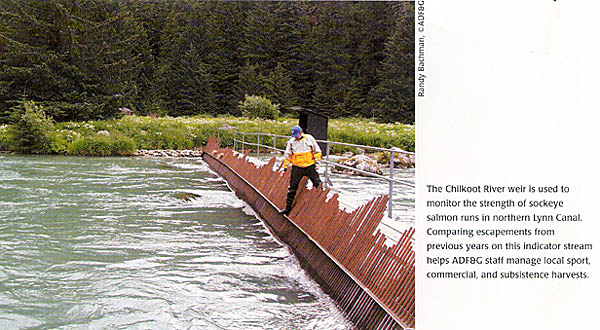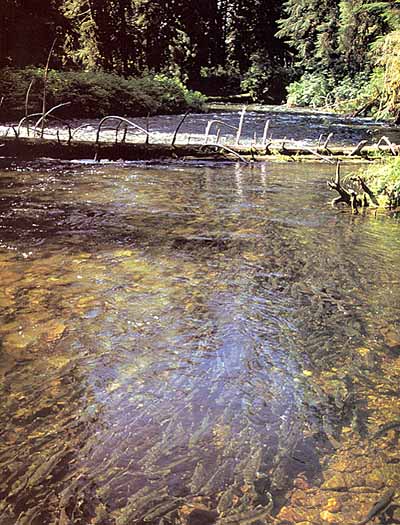
|

|

|

|

|

|

|

|

|

|

|

|

|

|

|
Chapter 6 Alaska’s Salmon Management & Research

|
Key Concepts |
|
|
The goal of salmon management in Alaska is to allow enough returning salmon to reach spawning grounds to sustain both salmon populations and related ecosystems, and to provide for the harvest of salmon that are surplus to those needs. Sound research provides the foundation for effective conservation, management, and harvest practices. |
|
|
Chapter Objectives |
|
|
Students will be able to: · explain how salmon in Alaska are managed on the basis of conservative management, sound science, and habitat protection; · explain the need and importance of in-season, abundance-based management; · describe or demonstrate some of the research techniques used to count, observe, and monitor salmon and to monitor environmental conditions necessary to salmon; · intelligently discuss the pros and cons, problems and advantages of hatcheries in Alaska. |
|
Terms Students Should Understand |
|
|
escapement – The number of salmon that need to be allowed to spawn and regenerate the run. |
(p. 54, col. 2) |
|
sustainability [sustained yield] – to preserve for the future while allowing use. |
(p. 54 col 1, p. 30 col. 1) |
|
Background for Teachers |
|
|
[none at this time] |
|
Questions For Discussion |
|
|
1. Review the Alaska Department of Fish and Game’s three principles of salmon management on p. 51 of Alaska’s Wild Salmon. See the description of conservative management on p. 54, explore what salmon science can teach us on p. 52 and on Alaska Department of Fish and Game web sites, and review what was learned in previous chapters about protecting salmon habitat. Why can adherence to these three principles be considered just as important as legal protections for salmon? |
Discussion of this question should help students pull together some of what they learned in preceding chapters about salmon biology, habitats that salmon use, harvests, and economic value of salmon. |
|
2. How do questions about the viability of hatcheries relate to what we learned about the evolution of salmonids in Chapter 1? |
|
|
3. What do we mean when we aim to make a natural resource such as salmon “sustainable”? |
Refer back to “sustainable yield” in the quote from the Alaska Constitution on p. 30. |
|
4. Some people say that sound management for salmon becomes more important as more individuals and groups compete to use salmon and their habitat. To what extent do you think this is true or not? |

|
Ideas for Activities |
|
|
1. Plan a field trip, invite a fisheries biologist to the classroom, or have students conduct research to understand the variety of methods and new technologies used to study salmon biology, population numbers, habitats, and related environmental conditions. Individual students or groups might explain or demonstrate to the class techniques particularly important to their community. Ask some students to find research statistics about salmon and salmon habitats in your region. |
|
|
2. Alaska has the second largest salmon hatchery program in the world. Yet many people, including some fisheries managers and political leaders, disagree about the value of hatcheries. Beginning with the information on p. 53 of Alaska’s Wild Salmon, ask students to research and present to the class some of the pros, cons, problems, and contributions of hatcheries in Alaska and the Pacific Northwest. What, if anything, do hatcheries contribute to your community? Do they pose any problems, and if so, what solutions can you suggest? |
|
|
3. Invite an elder from the community to describe traditional ways of knowing about salmon, salmon populations, and their habitat. Alternatively, students could interview elders to gather this information and present it in writing or visual form. |
|
|
4. Ask students to research information in order to answer the following question: Among Alaska’s five salmon species, kings are normally the most valuable per pound, followed by sockeyes and cohos. Why is it that most of the production from Alaska hatcheries is of pink and chum salmon? |
|
Resources Especially for Teachers |
|
|
[none at this time] |
|
Resources for Students and Teachers |
|
|
For information about the economic value of commercial fishing in Alaska, visit the Alaska Department of Fish and Game, Division of Commercial Fisheries web page and do a search for “Blue Sheet”. |
|
|
For information about the economic value of sport fishing in Alaska follow link on the Alaska Department of Fish and Game Division of Sport Fish page. |
|
|
For information about subsistence in Alaska, follow the Publications link to Community Profile Data Base, on the Alaska Department of Fish and Game, Division of Subsistence web site. |
|
|
A 2-page brochure on “Alaska’s Salmon Management” can be downloaded in Adobe Acrobat format. |
|
|
The “Fishery Research Programs” link on the Alaska Department of Fish and Game Commercial Fisheries home page leads to descriptions of tagging, otolith marking, and other research techniques. |
|
|
The Hatchery Home Page link on the Alaska Department of Fish and Game, Division of Sport Fish home page describes the statewide stocking program and research associated with it. |
|
|
This web site of the Coastal Alliance for Aquaculture Reform discusses nutritional and environmental dangers of farmed salmon and provides action plans for seeking industry reform. |
|
|
The primary purpose of this site primarily addresses the failure of hatcheries and the crisis of declining salmon stocks in the Pacific Northwest. |
|
|
Do a web search for “salmon hatcheries in Alaska” |
|
Looking Ahead |
|
|
What is it about the Pacific salmon life cycle that makes it important to involve a variety of groups and agencies in assuring that Alaska salmon stocks will remain healthy? |
Students should consider such factors as time spent in the ocean, variety of habitats needed, and the variety of governments and agencies that have control over the places where salmon live. |